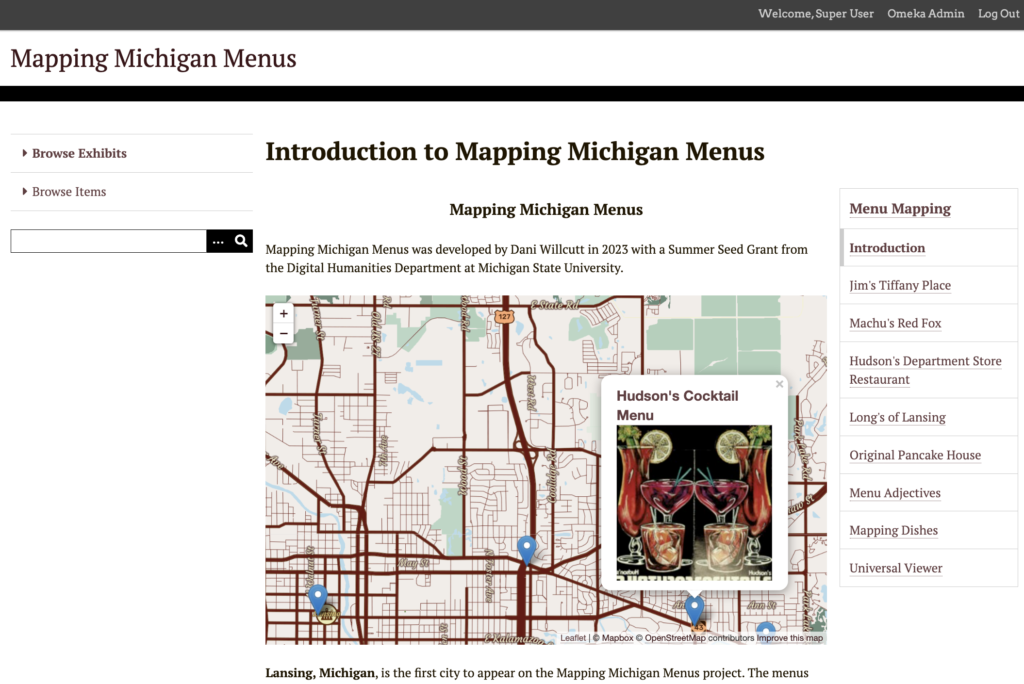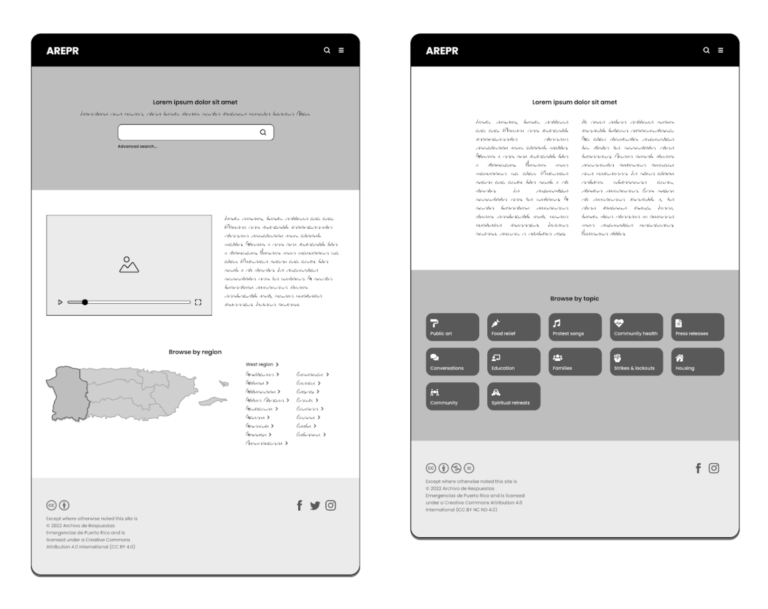Seed Grant Summer 2023 Report
Dani Willcutt
I requested the seed grant to support preliminary research for finding a methodology for using bar and restaurant menus as data. I knew that I needed to find menus that were specific to Michigan and to Lansing and that the seed grant would provide the resources to digitize some of those menus and turn them into a reusable dataset. What I did not know when I proposed the initial ideas for Mapping Michigan Menus was that I would soon come into possession of a large collection of menus with a Michigan focus. The MSU Broad Art Museum contacted Helen Veit, my dissertation advisor, in case she wanted to use a collection of thousands of food and drink menus from the 1960s to around 2008. Dennis Cassidy was the original owner of the collection. Beginning in 1966, Cassidy worked at Crown Publishing, which became Crown Menus in the 1980s when they primarily catered to the restaurant industry. Cassidy and his wife, menus from his own company and throughout his travels and was heavily Michigan-centric—the largest collection of such menus. To begin, in mid-May, I visited the collection at Jim Nelson’s house with Sandra Brown from the Broad Art Museum. I took a box of menus that day, mostly the menus I could find with a Lansing focus. This collection became the basis for most of my experiments for the rest of the summer and has turned into a larger project with Matrix Center for Digital Humanities and Social Science at MSU. In fact, the collection of menus is now housed in Matrix (as of September of 2023). But first, I will describe what I did over the summer months.
To begin with, I alphabetized the first small collection (around 175 menus) I had from the larger menu collection. I got the idea from Laura Kitchings, a food scholar and archivist who had been working with the John Mariani menu collection at Boston University. Mariani was a well-known food writer and restaurant critic during the late twentieth into the early twenty-first century who wrote for publications like Esquire magazine and Forbes. During his life and travels, Mariani collected his own set of menus, complete with notes written on them to help him remember aspects of the restaurants when it was time to write. Since there was a large batch of menus to go through, Kitchings decided to alphabetize them. This was one way of creating an unbiased organization system that was not based on categorical information or even prices. I began by doing the same with the Crown Menu Collection, or at least for the ones that I had during the summer. However, when it came time to go through the entire collection for the first time, it proved to be too large to begin the project with alphabetizing them. There are simply too many menus in the Crown Menu Collection. Instead, working with Peter Berg, we have decided to separate the menus by geographic region (Detroit-proper, Detroit-Metro, the rest of Michigan, then Other). This system is one way of beginning the preliminary pass-through of the menus.
I experimented with a few different ways of digitizing menus. Using the first batch of menus that I took in May, I created a database of menus using Google Sheets. The restaurant names went into an alphabetized spreadsheet, but I had to decide which categories were the most important to include. The categories I decided on were: Name (of the restaurant or bar), Year or Years (the menu was in use), Location (if multiple, Location_#, each with a separate column), Menu Publisher, Phone Number(s), Material (the menu is made of), Physical Description (of the menu), Restaurant Owner, Chef, Staff Members, Meals Served, and Hours of operation. Different categories were going to answer different research questions, so I wanted to think about what the metadata for a physical item should look like so that it could be best translated to a description.
I chose a menu from Jim’s Tiffany Place in Lansing, Michigan, during the 1970s as my first sample item. Jim’s Tiffany Place was a popular restaurant in downtown Lansing, Michigan, from the 1960s to early 1990s, when it closed. First, I scanned the menu, along with several others, using the CZUR Book Scanner in LEADR, the Lab for Education and Advancement of Digital Research. Then I decided to put them into an Omeka Classic exhibit, named Mapping Michigan Menus. By scanning the menus, more people can see the menu and interact with it, making it into a more accessible dataset. I added the Annotation plugin, which allowed me to draw boxes around the menu items, transcribe them, and describe them. Annotating the menus did not, however, make them machine readable and easily searchable.

Some of the menus were and are more difficult to scan because of their size and the material they are made of. Plastic-coated menus were convenient for keeping them clean in a messy restaurant or bar, but the material reflects light, which isn’t good for photographing. Some of the menus are printed on or protected by a layer of plastic that can handle spills and wear and tear in restaurants. But others were printed on paper. For some menus, this meant they were re-printed more often. Paper was easier for restaurants to print in-house and so it could be changed more often than menus printed on special material by a publishing company like Crown Menus. Chain restaurants, like Olive Garden and Applebee’s, were able to use more expensive material for their menus because they did not change often. Such restaurants rely on months of recipe development and market research to determine what to put on the menu. There was no variation in the items from a location in Lansing, Michigan, versus a location in Pittsburgh, Pennsylvania. This was not the complete rule, as smaller, family-owned restaurants like Flap Jack Restaurant in the Lansing-area and the Delhi Café in Holt, Michigan, both had large, plastic-coated menus in the 1990s. They were both larger than the black mat that came with the CZUR scanner and the menu went outside of the scanner’s view. The camera was able to capture a wider range, but the height of the base limited its scope. I raised the scanner up using books until it captured the entire height of the menus. Lighting, however, remained a problem.
The Seed Grant Proposal was to consider a prototype for “mapping” a menu. Preliminary research was to see what types of tools were available. I built an Exhibit named Mapping Michigan Menus using Omeka Classic. Adding menus as Items in Omeka makes it possible to include a metadata scheme that follows along with the information that is most important for researchers and scholars who would use restaurant menus as data.

Before receiving the historic menu collection, I thought about the ways that restaurant workers themselves could annotate a dish they made. What would they say about it? One way to “map” a dish through photograph or image is to map the provenance of the ingredients or the cooking and preparation methods. How could we integrate an Omeka plugin into Instagram? Eventually, I realized I was trying to answer two different concerns. The first was how to map a menu over time, or how we can use a menu to answer historical questions concerning food, dining, culture, foodways, economics, and society. This would look quite different from mapping questions about modern food systems, which might be more interested in questions of transportation, supply, and labor.
Using an example of Pozole Verde from Mita’s in Cincinnati, Ohio (yes, a step away from the strictly Michigan menus, but it was an interesting photograph to use in the project), I used the Annotation tool to label the dish and write what items and ingredients were used, including links for more information. Tagging components of a dish seemed to be a good way of collecting information, but a specific vocabulary would have to be used. However, would enforcing a lexicon for tagging dishes stifle ideas? Is there a way to group similar tags (for example: seafood, marsicos, fruits de mer, shellfish, oysters)? What would that look like?

What is Next
The Crown Menu Collection is now at Matrix where it is being sorted, preserved, and digitized. During the Spring 2024 semester, I will work at Matrix to design a website prototype for the collection. Soon, I would like to turn the menus into a machine-readable dataset for sentiment analysis. Consumption is a great way into what a group of people found to be “good” or “bad” during a particular time and place. Matching historical research with linguistic analysis of tastes and Tastes over time is bound to provide a lot of interesting material. Jim’s Tiffany Place purposely used words relating to and highlighting Greek cuisine. Oftentimes, the adjectives were used to describe the preparation method for the menu item. Items were not just cooked, they were “Broiled,” “Stuffed,” and “Skewered.” Meats were “Golden Fried Perch” and “Golden Fried Chicken.” How and when have these words changed over time and across geographic locations? The Text Analysis Omeka Classic Plugin is one possibility for moving this part of the project forward, although that is project for the future. I am new to topic modelling and have only begun learning about different types of text analysis – especially through Kate Topham and Devin Higgins’s Text Analysis Learning Group. The purpose of a seed grant is to help a project grow. This project certainly has and continues to grow from my original ideas.
